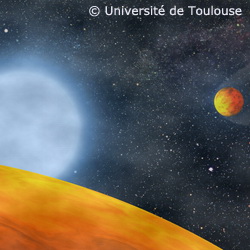Two new Earth-sized planets discovered
An international team of astronomers has detected two Earth-sized planets orbiting around an old star that was once a red giant and is now in a late phase of stellar evolution characterised by high levels of luminosity and low or intermediate mass. Writing in the journal Nature, the team, made up of researchers from Belgium, Canada, France, Germany, Italy, Poland, Spain and the United States, describe how this new planetary system they spotted, located a mere 3,900 light years from Earth, may have contributed to the increased loss of mass that their host star, KIC 05807616, experienced. The astronomers on the study believe this observation shows that planetary systems have a strong influence on the evolution of their parent stars. KIC 05807616 now consists of the exposed core of a red giant that has lost nearly its entire envelope. Forming this type of star requires the red giant progenitor to eject almost its entire envelope via a mechanism that significantly amplifies the normal mass loss from stellar winds and it seems highly likely that the two planets discovered around this star may have triggered such a process. 'The two planets, named KOI 55.01 and KOI 55.02 are on very short orbits around their host star,' explains one of the study authors, Gilles Fontaine from the University of Montreal. 'Having migrated so close, they probably plunged deep into the star's envelope during the red giant phase, but survived. The two observed bodies would then be the dense cores of ancient giant planets whose gaseous envelopes were vaporised during the immersion phase.' The team spotted the two new planets while carrying out routine observations of the host star. Suddenly they noticed the presence of two tiny periodic modulations reaching 0.005% of the star's brightness. As these variations could not be attributed to any repeating variations of the star or to any other sources, the only plausible conclusion was that there was something else out there. On the surface of these planets the conditions are without doubt far from bearable. These planets are only between 0.0060 and 0.0076 astronomical units (AU) (one AU is the distance between the Sun and Earth) away from their blaring hot host star where temperatures sizzle at 27,000 ° Celcius. Conditions like these have never before been found on planets that have been discovered outside our solar system. This finding certainly raises a few questions about what kind of life form - if any - could possibly live on such a fireball. These planets are referred to as Chthonian planets and they could be the remnants of ancient gaseous giant planets - perhaps a bit like hotter versions of Jupiter - that orbited the star when it was still burning hydrogen in its core, a very long time ago. The envelope of such a giant planet would have been dissipated during the immersion phase inside the star when the latter became a red giant. Only the dense cores of these planets, composed of iron and other heavy elements, would have survived this extreme episode.For more information, please visit:Université de Montréal:http://www.umontreal.ca/english/index.html
Countries
Belgium, Canada, Germany, Spain, France, Italy, Poland, United States



